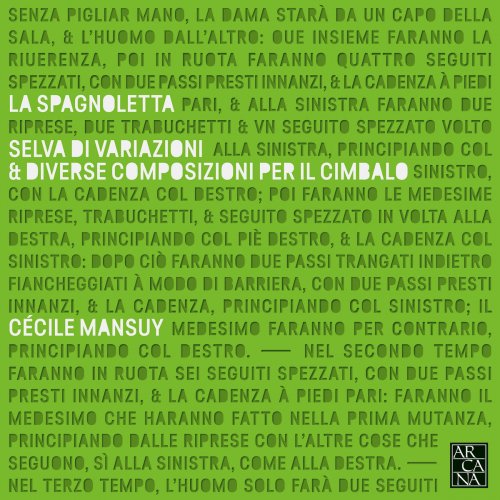Cecile Mansuy - La Spagnoletta: Selva di variazioni & diverse composizioni per il cimbalo (2018) [Hi-Res]

Artist: Cecile Mansuy
Title: La Spagnoletta: Selva di variazioni & diverse composizioni per il cimbalo
Year Of Release: 2018
Label: Arcana
Genre: Classical
Quality: flac lossless / flac 24bits - 96.0kHz +booklet
Total Time: 00:58:45
Total Size: 382 mb / 1.3 gb
WebSite: Album Preview
TracklistTitle: La Spagnoletta: Selva di variazioni & diverse composizioni per il cimbalo
Year Of Release: 2018
Label: Arcana
Genre: Classical
Quality: flac lossless / flac 24bits - 96.0kHz +booklet
Total Time: 00:58:45
Total Size: 382 mb / 1.3 gb
WebSite: Album Preview
---------
01. Tastata per cembalo
02. La Spagnoletta: La Spagnoletta: I. Prima
03. La Spagnoletta: La Spagnoletta: II. Seconda
04. Corrente
05. Ciaccone
06. Galiarda
07. Fitzwilliam Virginal Book, Vol. II: Galliard, F 166
08. The Old Spagnoletta
09. Spagnoletta
10. Fantasia
11. Capriccio VI sopra la Spagnoletta F 4.06
12. Gagliarda Seconda, F 3.28
13. Canzona Prima, F 3.13
14. Corrente e Ciaccona, F 2.33
15. Toccata decima, oder Zehendes Musikalisches Blumen-Feld
16. Partite diverse sopra la Spagnioletta: I. Partita
17. Partite diverse sopra la Spagnioletta: II. Partita
18. Partite diverse sopra la Spagnioletta: III. Partita
19. Partite diverse sopra la Spagnioletta: IV. Partita
20. Partite diverse sopra la Spagnioletta: V. Partita
21. Partite diverse sopra la Spagnioletta: VI. Partita
22. Ricercar
23. Aria sopra la Spagnoletta: Aria sopra la Spagnoletta: I. Prima Parte
24. Aria sopra la Spagnoletta: Aria sopra la Spagnoletta: II. Seconda Parte
25. Aria sopra la Spagnoletta: Aria sopra la Spagnoletta: III. Terza Parte
26. Aria sopra la Spagnoletta: Aria sopra la Spagnoletta: IV. Quarta Parte
27. Aria sopra la Spagnoletta: Aria sopra la Spagnoletta: V. Quinta Parte
28. Aria sopra la Spagnoletta: Aria sopra la Spagnoletta: VI. Sesta e ultima Parte
29. Passacagli sopra A la mi re
No, "La Spagnoletta" is not the name of a composer: it's the first piece on this album, which probably dates back to the late 16th century, and which provided many musicians with the raw material for fantasias, partitas, caprices, arias and all the conceivable musical forms then in vogue. We start with Giovan Battista Ferrini (1601-1674) and his Tastata per cembalo La Spagnoletta, followed by one of the "clearer" pieces, which takes up the source, The Old Spagnoletta by Giles Farnaby (1563-1640). Frescobaldi himself gets involved with his Capriccio VI sopra la Spagnoletta, while Johann Speth (1664-1719) throws in his Partite divers sopra la Spagnioletta and finally Bernardo Storace (1637-1707) his Aria sopra la Spagnoletta. So, clearly, this theme was one of the great sources of melodic inspirations of our times, a little like the Folie d’Espagne has inspired some five hundred composers in the years since it was written, right down to the present day. If the career of the La Spagnoletta as an inspirational piece didn't last as long, that's probably because it was pretty melodically complex. Cécile Mansuy plays on a unique Italian harpsichord with a "short octave" (that is, a layout of notes in the lower octave which differs from the normal system, so as to group together the most frequently-played notes), as well as split keys, in the style of various early-17th century instruments. Split keys? What’s that? A split-key keyboard is one in which certain notes, here E flat and D sharp on the one hand and G sharp and A flat on the other, each have a key to themselves – whereas on a piano they share the same key and are therefore treated as being identical. On split-key harpsichords, the musician can play on the organic difference in the respective functions of these notes; in reality, they are not acoustically identical: D sharp being a ninth higher than E flat, and the same for the others. That made it possible to avoid the sensation of hitting bum notes in a time before the "well-tempered" clavier had been developed.






![Keith Jarrett - Solo-Concerts Bremen / Lausanne (1073/2025) [Hi-Res] Keith Jarrett - Solo-Concerts Bremen / Lausanne (1073/2025) [Hi-Res]](https://www.dibpic.com/uploads/posts/2025-12/1766498595_b7uxg60700zwc_600.jpg)

![Eumir Deodato - Inútil Paisagem (As Maiores Composições de Antonio Carlos Jobim) [Bonus Track] (2025) Eumir Deodato - Inútil Paisagem (As Maiores Composições de Antonio Carlos Jobim) [Bonus Track] (2025)](https://img.israbox.com/img/2025-12/26/rc26x4ckfzr1mxaswj8nxutzu.jpg)